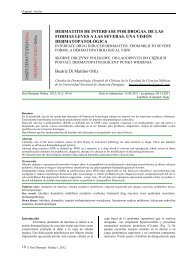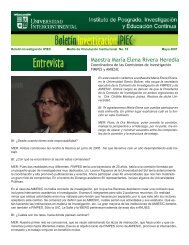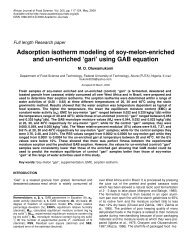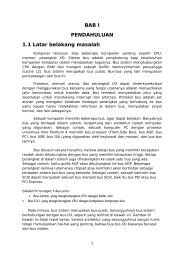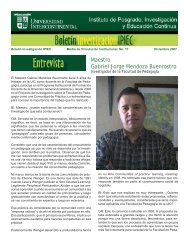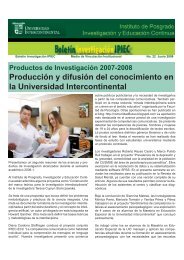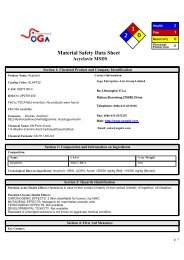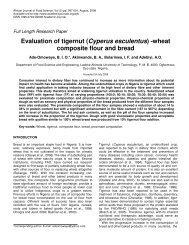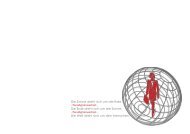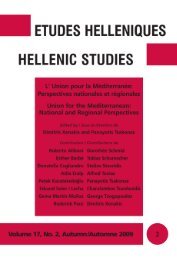Antimicrobial screening of stem bark extracts of ... - Science Stage
Antimicrobial screening of stem bark extracts of ... - Science Stage
Antimicrobial screening of stem bark extracts of ... - Science Stage
You also want an ePaper? Increase the reach of your titles
YUMPU automatically turns print PDFs into web optimized ePapers that Google loves.
090 Afr. J. Pharm. Pharmacol.<br />
<strong>extracts</strong> from the kernel <strong>of</strong> the plant is used extensively in<br />
cosmetics and chocolate industries (Nester et al., 1998;<br />
Parekh and Chanda, 2007; Pretarious and Watt, 2001;<br />
Agbahungba and Depommier, 1989; Soladoye et al.,<br />
1989; Dalziel, 1937; Ferry et al., 1974; Ndukwe et al.,<br />
2007; Ndukwe et al., 2007). There are however, few<br />
reports in the scientific literature concerning the antimicrobial<br />
properties <strong>of</strong> this plant. The work was therefore<br />
designed to investigate the antibacterial activity <strong>of</strong> <strong>stem</strong><br />
<strong>bark</strong> <strong>extracts</strong> <strong>of</strong> V. paradoxa and to determine the<br />
phytocostituents present in the plant <strong>extracts</strong>.<br />
MATERIALS AND METHOD<br />
Plant materials<br />
The <strong>stem</strong><strong>bark</strong> <strong>of</strong> V. paradoxa were collected from Sangere village<br />
<strong>of</strong> Girei, Girei Local Government Area, Adamawa State, Nigeria.<br />
The taxonomic identity <strong>of</strong> the plant was confirmed by Mr Bristone<br />
Basiri <strong>of</strong> the Department <strong>of</strong> Biological <strong>Science</strong>s, School <strong>of</strong> Pure and<br />
Applied <strong>Science</strong>s, Federal University <strong>of</strong> Technology, Yola. The<br />
plant parts were air-dried under shade to constant weight for 7-14<br />
days and the dried materials were reduced to powdered form using<br />
a pestle and mortar and then micronized using an electric blender<br />
(Kenwood). The powders were stored in airtight bottles until<br />
required.<br />
Extraction and determination <strong>of</strong> phytoconstituents<br />
Ten grammes (10.0 g) <strong>of</strong> the powdered plant material was soaked<br />
in 100 ml each <strong>of</strong> distilled water, 95% ethanol and acetone in<br />
separate 500 ml sterile conical flasks at room temperature with<br />
uniform shaking in a shaker water bath for 48 h. The content was<br />
then filtered with a muslin cloth and then Whatman No. 1 filter<br />
paper. The filtrates were evaporated to dryness and then packed in<br />
separate clean dry bottles and stored at room temperature until<br />
required. The <strong>extracts</strong> were screened for the presence <strong>of</strong> carbohydrates,<br />
tannins, alkaloids, saponins, phenolics, anthraquinones<br />
and cardiac glycosides as described by Trease and Evans, (1996)<br />
and Parekh and Chanda (2007).<br />
Test Organisms<br />
Eschericia coli, Klebsiella pneumonia, Proteus mirabilis, Shigella<br />
dysenterie and Salmonella typhi were collected in peptone water<br />
with the help <strong>of</strong> the laboratory staff from the Microbiology<br />
Laboratory <strong>of</strong> Specialist Hospital (750 bed capacity) Yola, Nigeria.<br />
Preliminary identification <strong>of</strong> the test organisms were carried out in<br />
the hospital laboratory. Biochemical tests to confirm the identity <strong>of</strong><br />
the organisms were carried out at the Microbiology Laboratory,<br />
Department <strong>of</strong> Microbiology, Federal University <strong>of</strong> Technology,<br />
Yola, Nigeria (Cheesbrough, 2002). The organisms were stored on<br />
Nutrient agar slants in a refrigerator (2-8 o C). Purity <strong>of</strong> the cultures<br />
was checked at regular intervals as described by Acheampong et<br />
al. (1988).<br />
Determination <strong>of</strong> antimicrobial activity <strong>of</strong> <strong>extracts</strong><br />
The agar well dilution method as described by Lino and Deogracious<br />
(2006) was used for this purpose. Standardized inoculum (0.5<br />
McFarland turbidity standard equivalent to 5 x 10 8 cfu/ml) NCCLS,<br />
1990) <strong>of</strong> each test bacterium was spread onto sterile nutrient agar<br />
plates so as to achieve even growth. The plates were allowed to dry<br />
and a sterile cork borer (6.0 mm diameter) was used to bore wells<br />
in the agar plates. The <strong>extracts</strong> were prepared to achieve different<br />
concentrations <strong>of</strong> 10, 20, 30, 40, and 50 mg/ml by redissolving in<br />
20% dimethylsulphoxide (DMSO). Subsequently, 0.5 ml <strong>of</strong> each<br />
concentration <strong>of</strong> the <strong>extracts</strong> was introduced in triplicate wells<br />
earlier bored in the nutrient agar plate cultures. Chloramphenicol<br />
(10 mg/ml) (Joabez Corporation) was used as a positive control and<br />
20% nutrient agar as negative control. The plates were then<br />
incubated at 37 o C for 24 h. <strong>Antimicrobial</strong> activity <strong>of</strong> the <strong>extracts</strong> was<br />
determined after incubation period by measurement <strong>of</strong> zones <strong>of</strong><br />
inhibition produced against the test bacteria.<br />
Effect <strong>of</strong> temperature and pH on activity<br />
This was carried out as described by Emeruwa (1982). Briefly 2.0 g<br />
<strong>of</strong> the sample powder was dissolved in 5 ml <strong>of</strong> distilled water in a<br />
test tube and the contents filtered. 1 ml each <strong>of</strong> the filtrate was<br />
pipetted into two separate test tubes. To the first test tube few<br />
drops <strong>of</strong> 1N HCl was added dropwisely until pH 3 was attained, and<br />
to the second test tube few drops <strong>of</strong> 1N NaOH was also added<br />
dropwislely until pH 10 was attained. All the <strong>extracts</strong> were allowed<br />
to soak for 30 min after which they were neutralized (pH 7) once<br />
again using the appropriate solvents. Another test tube containing<br />
<strong>extracts</strong> only (untreated) was left for the same period (30 min) to<br />
serve as control. <strong>Antimicrobial</strong> activity <strong>of</strong> both the treated and<br />
untreated <strong>extracts</strong> were then determined as earlier described.<br />
For the effect <strong>of</strong> temperature on antimicrobial activity, 2.0 g each<br />
<strong>of</strong> powdered plant <strong>extracts</strong> was dissolved in 6 ml <strong>of</strong> distilled water<br />
and filtered. 2 ml <strong>of</strong> the filtrate was pipetted into two different test<br />
tubes. Each <strong>of</strong> the test tubes were then treated at 4 o C (in the<br />
refrigerator) 60 o C and 100 o C for 30 min respectively using a shaker<br />
water bath. Another test tube containing the <strong>extracts</strong> was left at<br />
room temperature (untreated) for 30 min (control). After heat<br />
treatment, antimicrobial susceptibility <strong>of</strong> both the treated and<br />
untreated <strong>extracts</strong> was carried out against the test bacteria as<br />
earlier described.<br />
Determination <strong>of</strong> minimum inhibitory concentration MIC) and<br />
minimum bactericidal concentration (MBC)<br />
The MIC <strong>of</strong> the <strong>extracts</strong> against the test organisms was determined<br />
using the broth dilution method (Sahm and Washington, 1990).<br />
Briefly, 1.0 ml <strong>of</strong> the extract solution at concentration <strong>of</strong> 200 mg/ml<br />
was added to 1ml <strong>of</strong> nutrient broth to obtain extract concentrations<br />
<strong>of</strong> 200, 100, 50, 25, 12.5 and 6.25 mg/ml in different test tubes. 1 ml<br />
<strong>of</strong> an 18 h culture adjusted to 0.5 McFarland turbidity standard (1.0<br />
x 10 8 cfu/ml) was inoculated in each test tube. It was then mixed<br />
thoroughly on a vortex mixer. The tubes were incubated at 37 o C for<br />
24 h. The tube with the lowest dilution with no detectable growth<br />
was considered the MIC.<br />
To obtain the MBC, two loopfuls <strong>of</strong> broth culture were taken from<br />
the tubes that showed no growth in the above test tubes used for<br />
the MIC determination and were inoculated on to agar plates. The<br />
plates were incubated at 37 o C for 24 h and observed for possible<br />
growth. Concentrations that did not show any growth after incubation<br />
were regarded as the MBC.<br />
RESULTS<br />
The result <strong>of</strong> phytochemical <strong>screening</strong> <strong>of</strong> the <strong>stem</strong> <strong>bark</strong> <strong>of</strong><br />
V. paradoxa showed the presence <strong>of</strong> saponins, alkaloids<br />
phenolics, tannins, cardiac glycosides and carbohydrates<br />
(Table 1). <strong>Antimicrobial</strong> susceptibility <strong>of</strong> the <strong>extracts</strong> (50<br />
mg/ml) against the test organisms showed that in all the<br />
three solvents used, the ethanol <strong>extracts</strong> demonstrat



